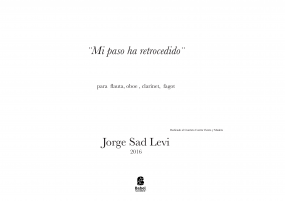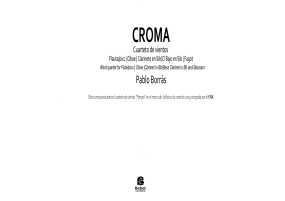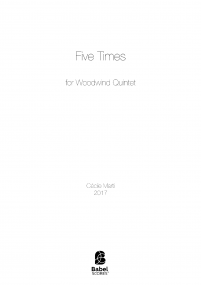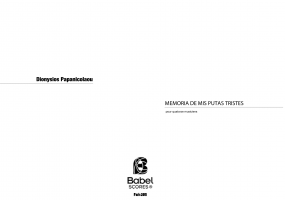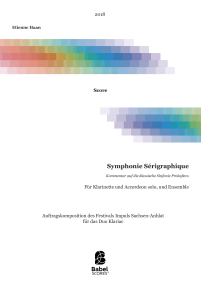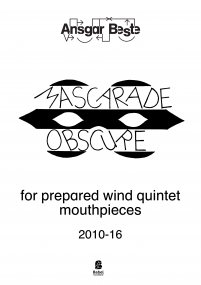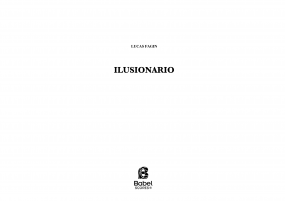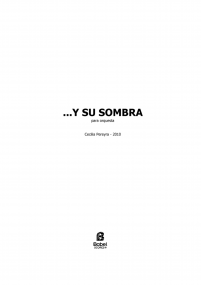Le Critérion
ISMN : 979-0-2325-0960-0
- Login to create your own lists
CAT# (YEAR COMPOSED): 56 (2000/2008)
INSTRUMENTATION: woodwind quartet (fl, ob, cl, bsn)
PAGES: 25
DURATION (APPROX): 10’
NOTE:
In Le Critérion, the expression I was interested in presenting was similar to Edward Said’s notion of an artwork exhibiting “intransigence, difficulty, and unresolved contradiction” in order to provide an “occasion to stir up more anxiety, tamper irrevocably with the possibility of closure and leave the audience more perplexed than before … to explore … a non-harmonious, non-serene tension, and above all, a sort of deliberately unproductive productiveness, going ‘against’…”
Murray Gell-Mann (Nobel Prize, 1969, for his work on quarks) identified that many quantities for complexity have been proposed, and that a variety of different measures are required to capture intuitive ideas about complexity and simplicity. Take for instance time/space measures – Gell-Mann suggested that one reliable indicator of complexity consists of how long it took a computer to perform any particular task, or the number of steps required to carry out a computation; whereas measures of information were related to the length of the shortest message conveying certain information. However, in ordinary conversation, the measure that corresponds to what is meant by complexity corresponded not to the “length of the most concise description” but rather the “length of concise description of a set of the entity’s regularities”. So that in a message that is effectively random, with practically no regularities: the effective complexity will be near zero. In a message that is completely regular, bit string of zeros, or perhaps an invariant rhythmic stream, the effective complexity may be near zero. However, in a message featuring effective complexity, complexity is high only in a region which is intermediate between total order and complete disorder.
PITCH
In the Le Critérion, the logistic equation, a model of population change, was applied to pitch and temporal characteristics. This recursive quadratic function generated sequences of numbers according to the formula:
Xn+1 = r xn(1 – xn) (0 < r < 4)
When control parameter r is less than 1, all iterated values decay to zero (meaning that a particular population becomes extinct), and not much use in generating longer sequences. As r increases between r = 1 to r = 3, the iterations converge to a single value, which is too static for my tastes. Then, between r = 3.0 and r∞ = 3.5699…, a series of bifurcations occur that are highly sensitive to value of control parameter, forming the well-known period doubling cascade. These sequences are somewhat predictable and such regularity generates little perceptual complexity, and therefore deemed not of much value for the creative project at hand. However, between r∞ ≈ 3.57 and r = 4.0 the iterated values produce complex behavior that feature all of the attractor states leading up to and including chaos. It was from these regions that I decided to extract integers from multiple r –values.
The resultant values were assigned to pitch classes that were encoded as either absolute pitch or as scalar degrees within two organizationally distinct, synthetic ten-note scales. Additionally, each value was assigned a temporal characteristic that included differing approaches to dealing with duration, placement within a time series, metric and strata within the so-called embedded rhythmic detail.
The intention of utilizing the logistic equation was to explore the internal characteristic of the deeply-hidden windows of periodicity leading up to and within chaos.
TIME
In regards to the metric hierarchy, I attempted to mediate between local details and global levels of organization. Meter as the primary organizer of the temporal domain was abandoned. Multiple layers of integers were independently developed and used to structure texture, rhythm, and gesture. Rhythmic cells were developed with an eye to how asymmetrical groupings might achieve momentum and climax without resting on a massed iteration of similar tactus. Philosophically, this suggests an increased acceptance of developing a fuller range of temporal potential, and relates fundamentally to dynamical systems.
MULTIDIMENSIONAL NETWORKS
In order to build redundancy across diverse procedures and elements (such as instrumentation, register, pitch, articulation, source characteristics) similar processes were coupled with multiple strata in order to heighten functional hierarchies. Such attempts to build in a higher degree of internal redundancy reflect a desire to embed wholly within the compositional fabric those elements that exist in addition to traditionally identified pitch and rhythmic axes.
This working process structured each element according to its acoustical function:
I. Power (for voice: airflow – either egressive or ingressive)
II. Source (for voice: vocal folds, or other periodic or nonperiodic turbulence)
III. Articulation/Resonance (for voice: articulators of upper vocal tract)
IV. Heightened Potentials (for voice: multiple source generators, decoupled production behavior, etc)
FORM AND STRUCTURE
Le Critérion used a dynamical approach to generate materials. This dynamism allows for local dissonance and resolution in relation to higher-level structures and with other factors, such as the multidimensional parameters loosely connected under the term ‘texture’ and rhythm. Constructively, it is not enough to merely self-replicate at different temporal locations and/or dimensional plateau, but I wanted to make an allowance for maneuverability at the local context and to build redundancy throughout different strata at structural-temporal locations.
Another feature of this dynamic involves the desire to respond to feedback generated from materials developed within this same piece. This means that the system or working out process may change at the level of detail, mid-level structure or even global form. At an extreme, the openness to consider irrational and unexpected events might even bring about new generative materials or procedure at any level of the compositional process. Such change might result from intuition or from alternative generative procedures embedded within or externally attached to any particular system. From research focused on dynamical bioacoustics I understand that non-responsive environments do not represent very well the complexity of dynamic models found with living biological systems. So that if any system is not able to encompass irregularities, then it will invariably cease to function; and in a loose way, I try to embody such concepts into my compositional processes.
An article in the October 2004 issue of Scientific American, titled, “The Hidden Genetic Program of Complex Organisms” by John S. Mattick provided valuable information regarding the issue of complexity from a meta-control standpoint, rather than simply presenting formuli designed to represent stereotypical near-randomness or chaos. Mattick writes:
“Protein-coding genes obviously specify the components of organisms, but where does the architectural information reside? Biologists have widely assumed that the instructions for assembling complex organisms are somehow embedded in the diverse combinations of regulatory factors within cells – that is, in the permutations of regulatory proteins interacting with one another and with the DNA and RNA. Yet, as Daniel C. Dennett of Tufts University has observed, although such combinations can generate almost endless possibilities, the vast majority will be chaotic and meaningless – which is problematic for biology. Throughout their evolution and development, organisms must navigate precise developmental pathways that are sensible and compatible, or else they die. Generating complexity is easy – controlling it is not.”
Later Mattick suggests that as any system becomes more complex, the amount of regulation must increase, and in a nonlinear function relative to the number of genes; therefore all systems must have an intrinsic complexity limit.
In Le Critérion the paired notions of large-scale architecture and localized regulation were issues that stimulated my creative process. It was fairly easy to imagine what an upper limit to complexity would resemble – that above a certain activity an absolutely chaotic mass with no shape would have little perceptual complexity – but of course, in practice just what that would resemble is never clear-cut. But, rather than map a documented series of permutations through a sonification process, I wanted to work in a less automatic fashion, in order to assess or build in a feedback loop into the process. So, in effect, the regulatory process involved not only synthetic forms derived from descriptive texts and generative processes related to the integers provided through the logistic equation, but also through an intuitive feedback loop. Still, the notion of increased regulation with increased complexity can intuitively serve formalistic, generative methods – but would this be a proper understanding of regulation?
Further, we may interpret such system regulation as a reduction of unpredictability or indeterminacy. Similarly, Mitchell Feigenbaum suggests that the “complexity of structure is not the result of complicated interwoven processes”; rather he suggests that “in the presence of a complex pattern there is a good chance that a very simple process is responsible for it.” Discovered in 1975, The Feigenbaum constant is a universal constant for functions approaching chaos via period doubling; so that within chaos, we find islands of periodicity.
Similar to Feigenbaum’s notion of an underlying simplicity to complexity, Gell-Mann suggests that it is “hard to tell whether something that is apparently complex really possesses a great deal of effective complexity or reflects instead underlying simplicity combined with a certain amount of logical depth.” He notes that the fractal set, generated by Mandelbrot, can be generated from a very simple formula, so that it features a logical depth, rather than an effective complexity. A distinguishing characteristic between effective complexity (surface detail) and logical depth (structure) is important to understand function as an analyst or within a generative (creative) process. For instance, at the atomic level, the patterns of energy movement seem extremely complicated, and therefore may easily be thought to be the result of some fundamentally complex law. However, science now suggests that such effective complexity results from elegant, yet simple fundamental laws that govern phenomena such as quarks, gluons and photons.
As science is on record for suggesting that fundamental laws governing the behavior of all matter in the universe are quite simple – it might be worth while examining such principles in order to better to understand complexity in the arts. Gell-Mann asks that if the boundary condition specifying the initial condition of the universe around at the beginning of its expansion may be based upon simple laws, then does this mean that there is hardly any effective complexity in the universe? His answer was that “no, not at all” and that complexity is due to the relentless operation of chance, or to the inherent nonlinearity of the universe.
Although difficult to analyze, current scientific understanding agrees that strong nonlinearities exist in natural phenomena. While, some twenty years ago, nonlinearity was often treated as essentially a simple distortion of linear behavior, published research over the last ten to fifteen years has found that nonlinear behavior is widespread and qualitatively distinct from linear ones. One of the most striking findings suggests that dynamical systems consist of specific, measurable regimes on the way to ‘chaos.’
Dynamical systems may feature a lack of predictability (chaos) despite the absence of randomness. This absence is dependent upon its particular dynamical state or regime, which consists of a highly complicated subspace — the so-called strange attractor. When applied to sound, these attractor states include:
– steady state (represented by no sound)
– limit cycle (represented by a periodic tone)
– folded limit cycle (represented by subharmonics)
– torus (represented by two or more independent frequency contours)
– chaos (represented by nonperiodic, irregular and complex frequency bands)
The musical compositional approach popularly known as complexity (or even as new complexity) is characterized by an experimentation of form through asymmetrical ratios and angular gestures. The musical languages frequently feature atonal or rapidly shifting non-functional pitch hierarchies within dissonant contexts that are mostly defined through highly complicated temporal and/or rhythmic features, often with an interest in timbral diversity through non-scalable extended performance technique.
Why write such complicated notation? My idea is not to use a notation that a) does not represent an imagined sound or context, nor b) to set up a trivial sound-kinetic or merely physically gestural activity, nor c) an imbecilic critique of performance practice that merely replaces one aesthetic with another (or in a worse case scenario, one level of proficiency with another lesser developed standard!), nor d) a sado-masochistic relationship (the composer as sadist, the performer as masochist), nor e) a postmodern redefinition from a sterile performance practice found in modernist traditions. Rather, my idea is that the performer take part in an openly dynamical environment, in which inherent system instabilities (whether due to kinetic and/or neurological factors of performer or sound production system) may be activated in performance; as for example, when desynchronized elements involved in producing sound are exploring the extreme limits of minimal or maximal values. The results of such behavior may impact sound quality, ensemble coordination, gestural stability and identification, among others. In regards to sound production, such dynamical features may be responsible for producing bifurcations between any of the attractor states, which opens up the potential for a non-deterministic, yet-fully representative framework, thus allowing the inherent nonlinearities of all bio-mechanical systems to be fully recognized as philosophically legitimate and aesthetically pleasing.
Pages - 28




